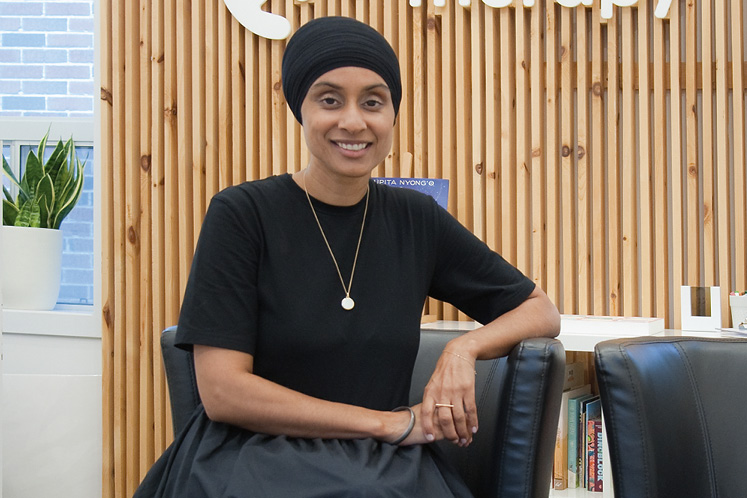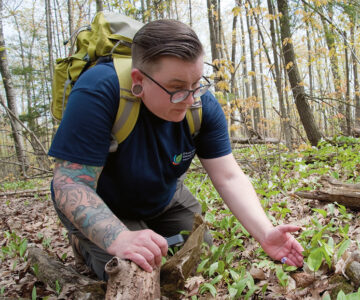Portrait of the Art Therapist
Rapinder Kaur built a therapy practice around encouraging children, and adults, to listen to the wisdom of their inner artists.
There’s a tidy little house on First Street in Orangeville with a sign in the front yard reading Art as Therapy. It is the realization of a dream registered psychotherapist and art therapist Rapinder Kaur nurtured earlier in her career while working with children who had experienced developmental trauma. She often thought group homes and other such settings weren’t always conducive to providing the most effective help for mental health issues.
“I was seeing children who were part of the child welfare system, children who had been through tremendous turmoil and disruption – even cruelty – and I was adamant that if I was going to open a private practice that it was going to be a really safe space, a refuge and a haven – a space for clients to explore their creativity and discover their inner power.”

Rapinder Kaur in her Orangeville clinic. Photos by Rosemary Hasner.
The first Art as Therapy opened in Orangeville the summer of 2009 (there are now also offices in Milton and Brampton). Art in a therapeutic setting – complete with an endless supply of craft materials, markers, coloured paper and more – can allow clients to express thoughts and feelings that might otherwise be difficult to articulate. With children in particular, the ways they engage with different materials, how they manage creative challenges and emotions, and how they interact with the therapist helps reveal underlying issues – and how to tackle them. “It is so encouraging to be in a session and journey from despair to optimism. They come in down, but leave with a smile, thinking, ‘Yes, we have problems, but we can handle them.’”
The Orangeville office moved to this new, bigger location just as the pandemic arrived, but Rapinder and staff were forced to conduct sessions online. There are still occasional online sessions for clients and Rapinder holds video workshops – with clients as far away as Bali and Korea.
Rapinder puts in long days keeping the centres running smoothy – and fulfilling other community obligations. Team meetings are on Mondays; eight other therapists work in Orangeville, plus a client care co-ordinator. Fridays are for research and professional development, administrative tasks and more meetings. I caught up with Rapinder on a recent Wednesday afternoon, just as she was finishing with clients and welcoming community members to the weekly Art Hive open house.
7 A.M. Most weekdays begin quietly, sometimes with yoga, but always with morning prayers. Rapinder is Sikh; prayer is an important part of her daily routine.
8 A.M. Rapinder checks emails, takes phone calls, and has breakfast with her family, although it often tends to be more like a meeting. “Sunny, my partner in business and life, supports the practice behind the scenes, so our mornings consist of me sharing a long to-do list.” Rapinder gets her three-year-old son, Hazoor, ready to go to one of his two sets of grandparents for the day.
9:30 A.M. Rapinder begins the drive north to Orangeville, often listening to a TED Talk or podcast about mental health.
10 A.M. Rapinder sees clients in one of the five therapy rooms, three on the main floor and two upstairs, or outside in good weather.
For younger patients, much can happen without the familiar conventions of talk therapy. “Art, play or drama therapy are wonderful tools for expression that allow a child to share symbolically their inner world,” she says. “A child may experience heightened excitement, anger or impulsivity in the therapy room, and be able to channel that through balloon tennis or making a baking soda and vinegar volcano. They may experience low energy, anxiety, fear and low mood, but by engaging in painting they feel better and more optimistic.”
2 – 3:30 P.M. Lunch, either from home or one of her favourite local restaurants.
3:30 P.M. More client sessions. Rapinder shares a recent case: “I worked with a child who had a hard time managing big emotions at home and school. His parents were at a loss. The cycle of punishment and reward was not working. In therapy we built things, played games, made elaborate designs with string and paint. The child tried new things, solved problems, managed frustration when things didn’t go to plan. He experienced wonder and excitement when the unexpected happened. He could spray shaving cream and express his anger; he could be himself without judgement or fear. He was no longer angry, always in trouble. He was an artist, scientist, creator, disruptor, and someone who had the power to make a change in his world. My work with him was glorious, magical and life affirming. We are all inherently creative and powerful.”
4 – 6 P.M. The Art Hive on the building’s main level is abuzz. It’s an inclusive space for everyone, regardless of background, age or artistic ability and is meant to increase self-awareness, build relationships and strengthen community life – via paper, paints, crayons, yarn and many, many glue guns. “You never know what’s going to happen. It’s freeflowing, a space for people to feel a sense of connection,” says Rapinder.
Since my visit, the Art Hive has left the nest for a permanent location next door, at number 47. “We have a vision to make this space available to the community and different groups to come together – a knitting group for older adults, or a comic club for young teens, or an art club, or a place for us to run more art therapy or drama therapy groups.”
6 P.M. As Rapinder describes it, she wears many different turbans. She serves on the board of Family Transition Place and Dufferin Child & Family Services. Often there are board meetings Wednesday evenings. Rapinder is also a program volunteer for the Sikh National Archives of Canada. How does she do it all? For one, “I don’t make dinner.” All those grandparents are a big help on that front.
8 P.M. Now at home, Rapinder makes client notes from the day and responds to team queries. She creates Instagram posts to keep Art as Therapy visible on social media. And she creates her own art, using watercolours and markers. “It’s a tool for self-reflection and to help me process the work I do with clients.”
Related Stories

Caledon’s Biggest Thrift Store Thrives Thanks to This Secondhand Superhero
Sep 8, 2023 | | A Day in the LifeFor Catherine Adair, Evolve Caledon’s tagline – Shift to Thrift – is a mission.

Seeing The Forest And The Trees
Jun 16, 2023 | | A Day in the LifeField botanist Lisa Riederer painstakingly inventories trees, shrubs and groundcover plants for Credit Valley Conservation.








